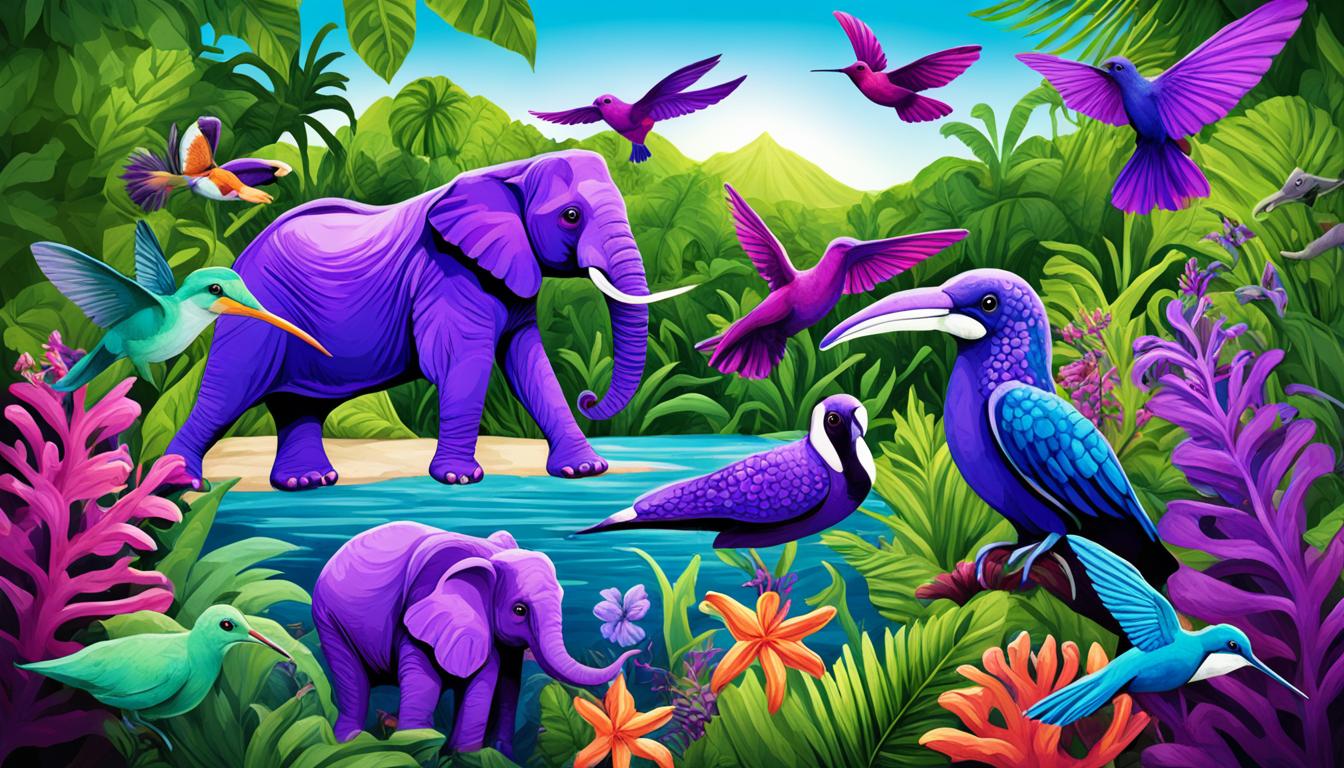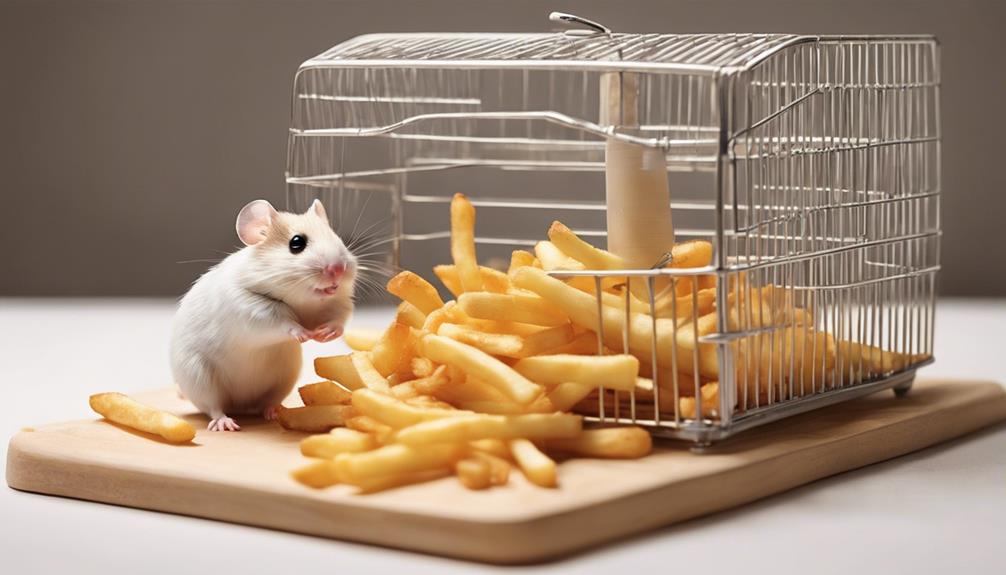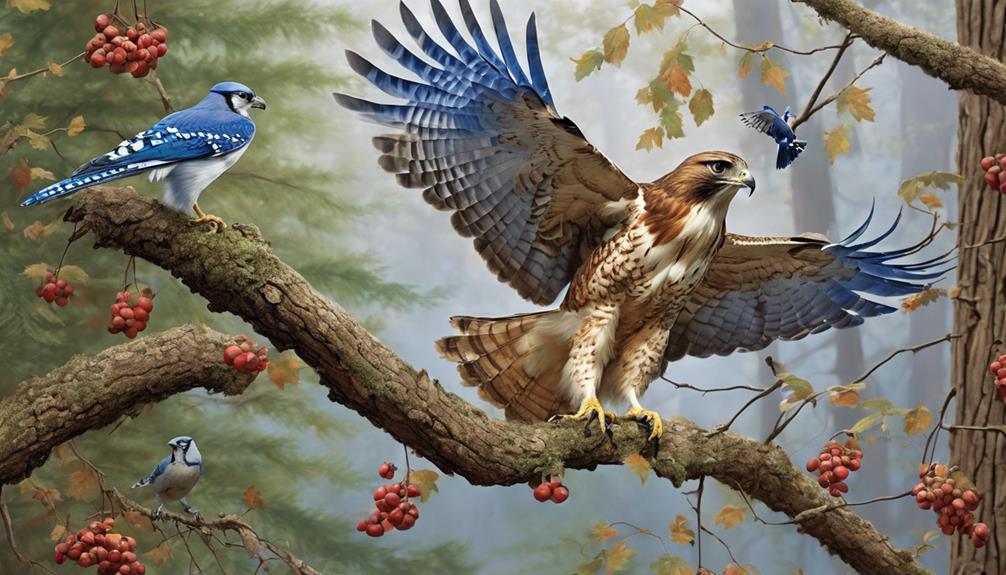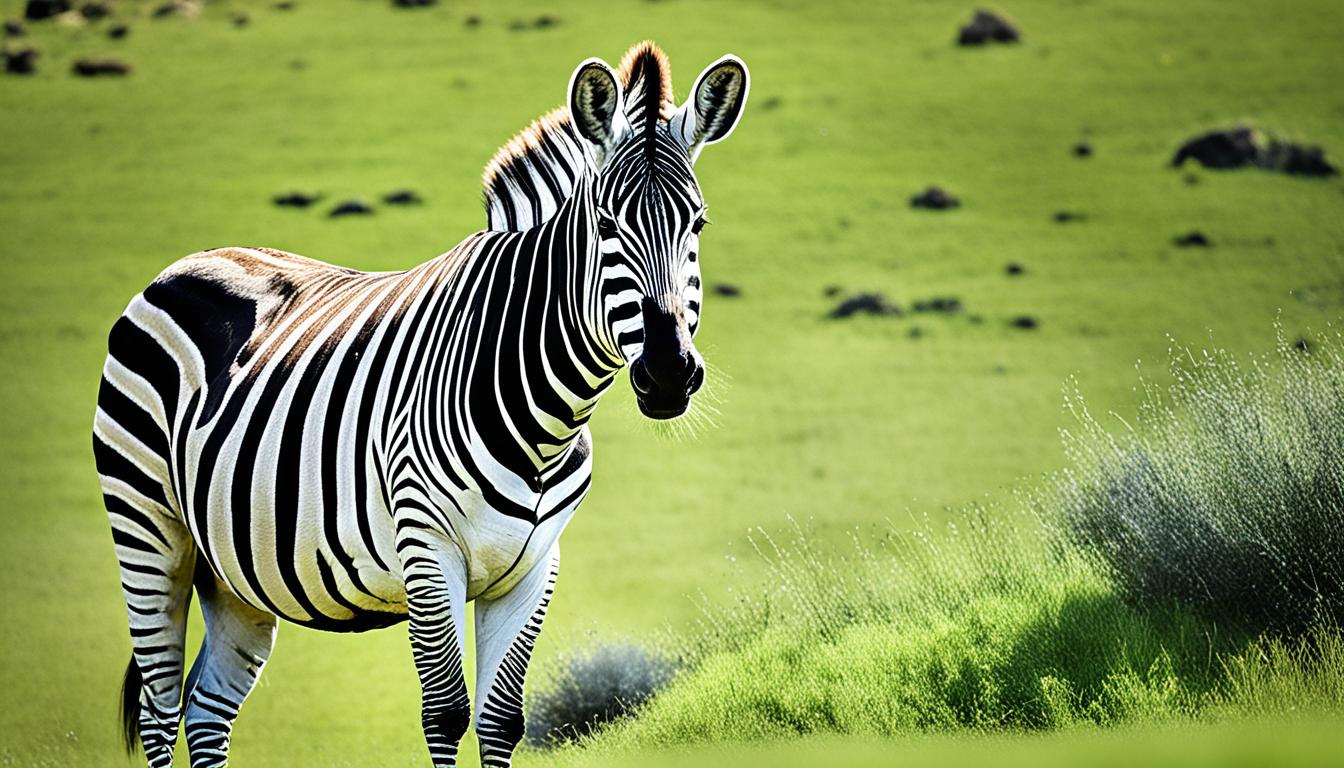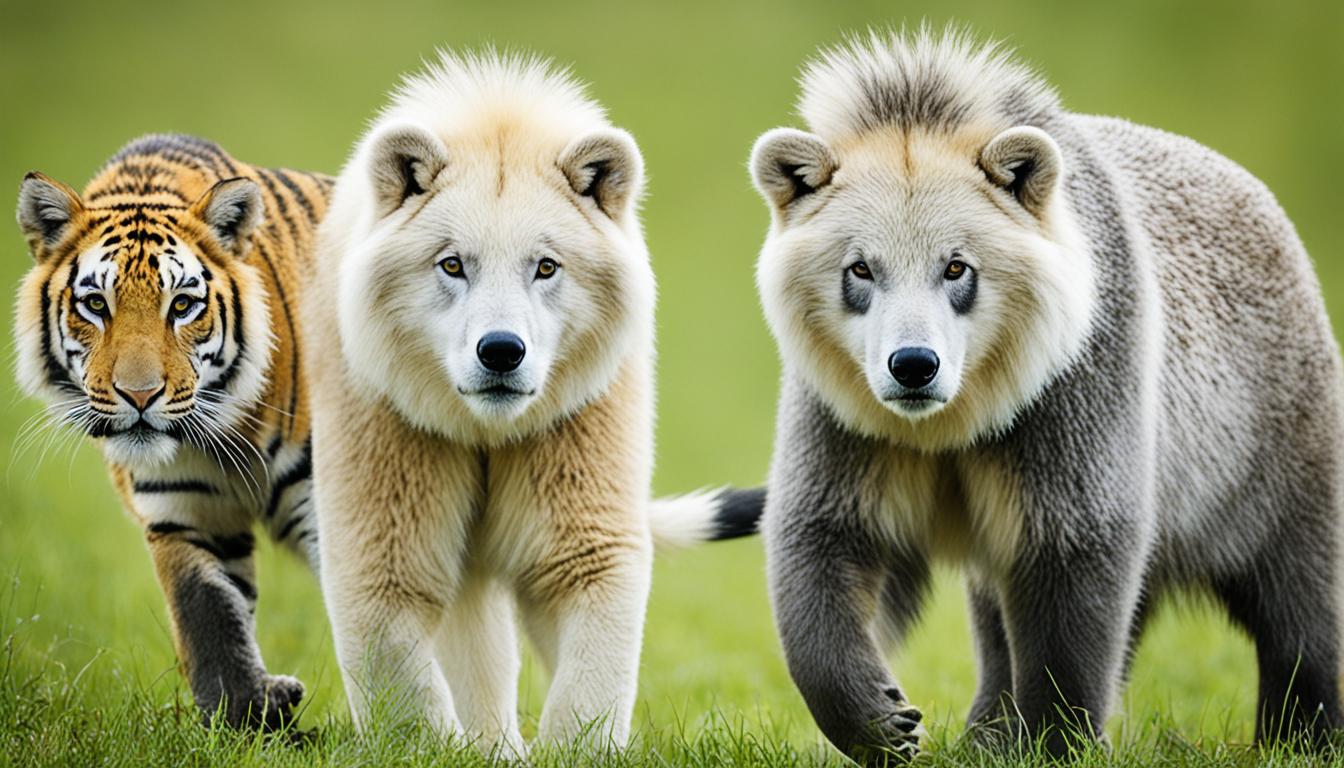Purple is an uncommon color in the animal kingdom, but have you ever seen the fascinating creatures that display this vibrant hue? From birds and insects to sea creatures and amphibians, these purple animals are nature’s living jewels. Come along on a journey to unveil the mysteries and beauty of these unique purple animals.
Key Takeaways:
- Purple animals are a rare and beautiful sight in nature.
- Their stunning purple colors serve various purposes, from attracting mates to warning predators.
- These vibrant creatures add a touch of extraordinary beauty to our natural world.
- From the violet-backed starling to the purple grenadier, discover the diverse range of purple animals.
- Explore their habitats and learn about the significance of their unique appearances.
Violet-Backed Starling
The violet-backed starling is a stunning purple bird found in sub-Saharan Africa. With its glistening purple head and back contrasting beautifully with the bright white belly, this species stands out in woodlands and savannas near forest edges. The males, in particular, exhibit a deep royal purple color, while females are more brownish in appearance. These starlings are also sometimes referred to as plum-colored starlings or amethyst starlings.
In sub-Saharan Africa, the violet-backed starling is a common sight, bringing a dazzling burst of color to its surroundings. These beautiful birds are known for their melodious songs and acrobatic flight patterns, captivating birdwatchers and nature enthusiasts.
One of the most remarkable features of the violet-backed starling is its vibrant plumage. The deep purple feathers are a result of structural coloration, where microscopic structures within the feathers reflect and scatter light, creating the stunning hues. These colors play a vital role in courtship displays, with the males’ vivid purple plumage attracting mates during the breeding season.
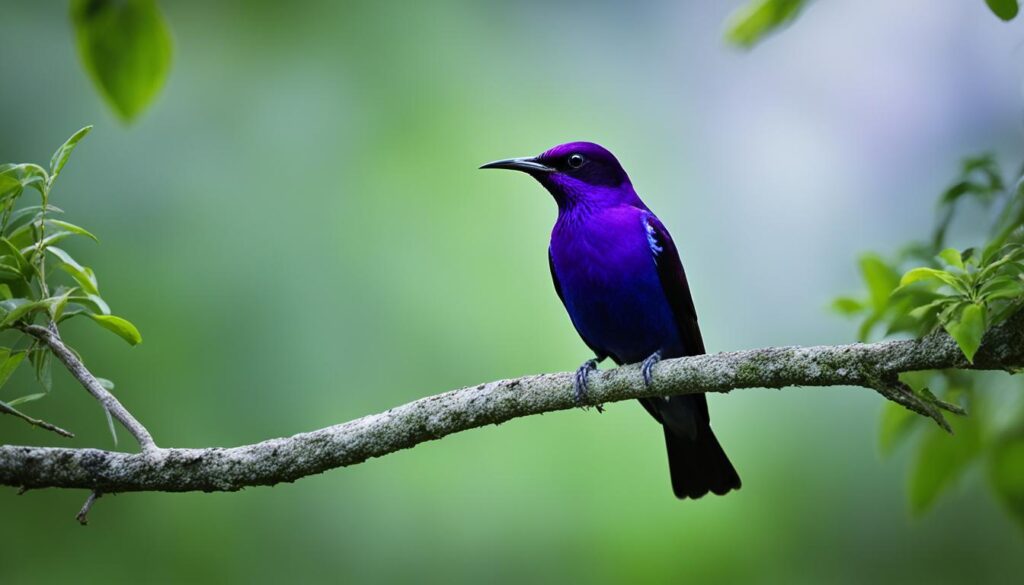
“The violet-backed starling’s iridescent plumage is a true marvel of nature, captivating anyone lucky enough to observe it in its natural habitat.”
Population and Distribution
The violet-backed starling is primarily found in sub-Saharan Africa, with its range extending from Senegal in the west to Ethiopia and Somalia in the east. It inhabits a variety of habitats, including woodlands, savannas, and forest edges near water sources.
These birds are highly adaptable and can often be seen nesting and foraging in close proximity to human settlements. They are skilled at exploiting available food resources, including fruits, seeds, and insects.
Conservation Status
The violet-backed starling is listed as a species of least concern on the International Union for Conservation of Nature (IUCN) Red List. However, like many other bird species, it faces threats such as habitat loss and fragmentation due to human activities.
Conservation efforts are crucial to ensure the long-term survival of the violet-backed starling and other bird species in sub-Saharan Africa. Protecting their habitats and raising awareness about the importance of biodiversity are essential steps in preserving these beautiful creatures for future generations.
| Common Name | Violet-Backed Starling |
|---|---|
| Scientific Name | Cinnyricinclus leucogaster |
| Family | Sturnidae |
| Size | Average length: 20 cm (8 in) |
| Weight | Average weight: 65 g (2.3 oz) |
| Habitat | Woodlands, savannas, forest edges |
| Range | Sub-Saharan Africa |
Purple Sea Slug
The purple sea slug is a small but vibrant creature found in shallow waters across the Indo-Pacific. Ranging from pale lavender to vivid electric purple, these sea slugs are among the most colorful creatures in the world. Their foot is often bright white, providing a striking contrast to their purple bodies. Divers and snorkelers exploring warm-water coral reefs often have the opportunity to spot these beautiful purple sea slugs.
These sea slugs belong to the scientific family Glaucidae, which is comprised of multiple species. Though small in size, their vibrant color and unique appearance make them stand out in the underwater realm. They are benthic creatures, spending their lives close to the ocean floor.
The purple sea slug’s vivid hue serves as a form of self-defense. By displaying such vibrant colors, they warn potential predators of their toxicity, hinting at the presence of chemicals that could inflict harm. This defense mechanism is known as aposematism.
These beautiful sea slugs are truly a sight to behold. Their vibrant colors captivate the eyes and add a touch of mesmerizing beauty to the underwater world. It’s a privilege to witness these creatures in their natural habitat and appreciate the wonders of nature.
One of the most stunning species of purple sea slug is the Glaucus atlanticus or blue dragon. Despite its name, the blue dragon displays an enchanting purple color as well. This species can be found in both the Atlantic and Indo-Pacific oceans.
The Adaptations of the Purple Sea Slug
The purple sea slug possesses several adaptations that enable it to thrive in its unique marine habitat. These adaptations contribute to its vibrant color and overall survival:
- Toxicity: The purple sea slug is armed with venomous nematocysts acquired from its prey, namely Portuguese man o’ war and other jellyfish. These toxins protect the slug from predators and deter them from making a meal out of this small but formidable creature.
- Camouflage: The slug has the ability to assimilate certain pigments from its prey, allowing it to change its color in response to its surroundings. This adaptation helps it blend in with its environment, making it less visible to predators.
- Buoyancy: The purple sea slug floats at the water’s surface, utilizing a gas-filled sac within its body to control its buoyancy. This allows it to move, float, and navigate with ease.
The purple sea slug’s adaptations and vibrant color contribute to its survival in the competitive marine ecosystem. They are a testament to the incredible diversity and beauty found in the natural world.
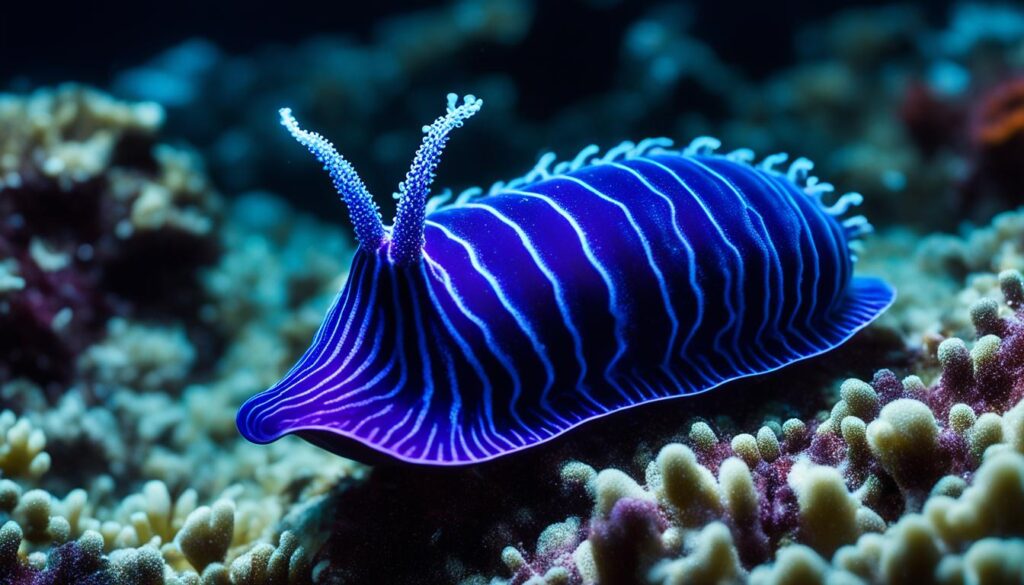
Stay tuned for the next section, where we’ll explore another fascinating purple creature – the purple honeycreeper.
Purple Honeycreeper
The purple honeycreeper is a small but colorful bird found in the forest canopies and plantations of northern South America. While the males exhibit a blue-violet color rather than a true purple, they are still incredibly vibrant and eye-catching. The females, on the other hand, display pastel yellow breasts with blue-green streaks. These birds are bold and coordinated, often mobbing potential predators to protect their chicks.
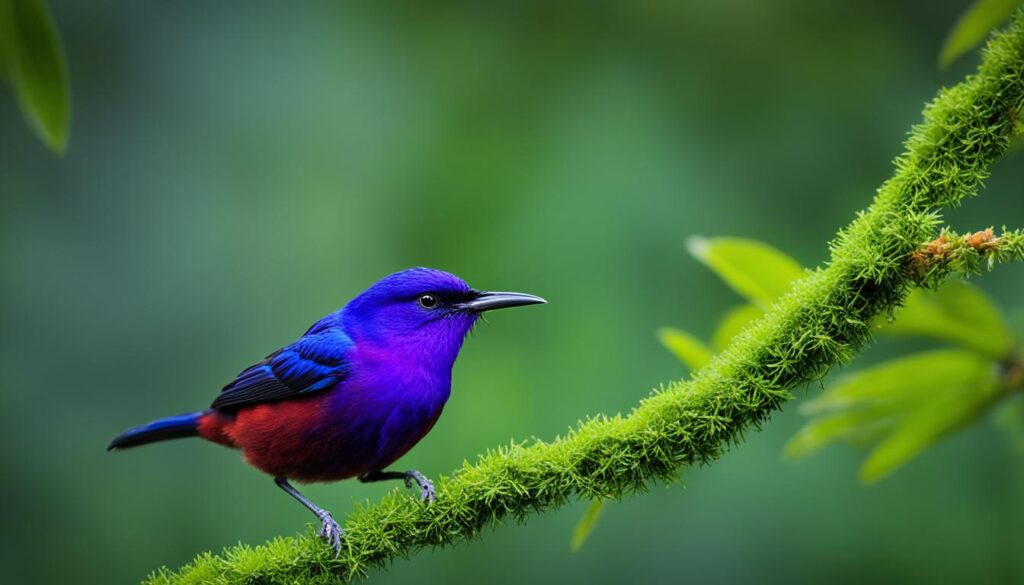
The purple honeycreeper is a stunning example of the colorful diversity of birds in South America. Despite its small size, this species stands out with its vibrant colors and fearless behavior when defending its young.
Yellowstriped Fairy Basslet
The yellowstriped fairy basslet is a vibrant purple fish that can be found in coral reefs across the Indo-Pacific. With its delicate appearance and bright purple color, coupled with a yellow dorsal stripe, this species is truly a sight to behold. Its stunning beauty adds to the vibrancy of the underwater world, capturing the attention of divers and snorkelers alike.
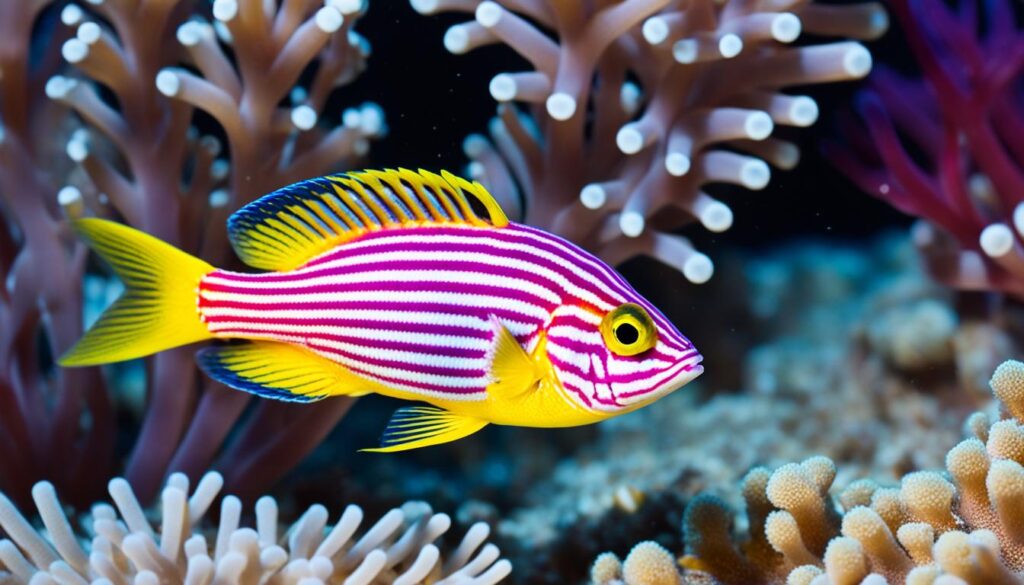
However, despite its captivating appearance, the yellowstriped fairy basslet is a challenging fish to keep in aquariums. It is highly sensitive to changes in its environment and requires specific conditions to thrive. Additionally, this species is known to be a picky eater, often refusing food provided in captivity.
When observing the yellowstriped fairy basslet in its natural habitat, one can witness its graceful movements as it navigates the vibrant coral reefs. These reefs serve as essential ecosystems, providing food and shelter not only for the basslet but for a plethora of other marine life as well.
The coral reefs of the Indo-Pacific are renowned for their biodiversity and are teeming with colorful and vibrant fish. The presence of the yellowstriped fairy basslet adds to the kaleidoscope of colors, creating a visually stunning underwater landscape.
Purple Emperor Butterfly
The purple emperor butterfly is a majestic species found in densely wooded areas from Europe to China. These striking butterflies captivate with their dark wings and iridescent sheen, giving them a purplish-blue appearance. While the males boast predominantly black or dark brown wings, it is their iridescence that truly sets them apart. On the other hand, females possess more subdued coloration and lack the vibrant iridescence exhibited by their male counterparts.
What makes these butterflies even more fascinating is their unique feeding habits. Rather than relying solely on nectar, they have a taste for unexpected sources. They eagerly seek out aphid honeydew, oak tree sap, and even animal carcasses as nourishment. This peculiar diet contributes to their distinctive coloring, as they extract essential nutrients that enhance their purple hues.
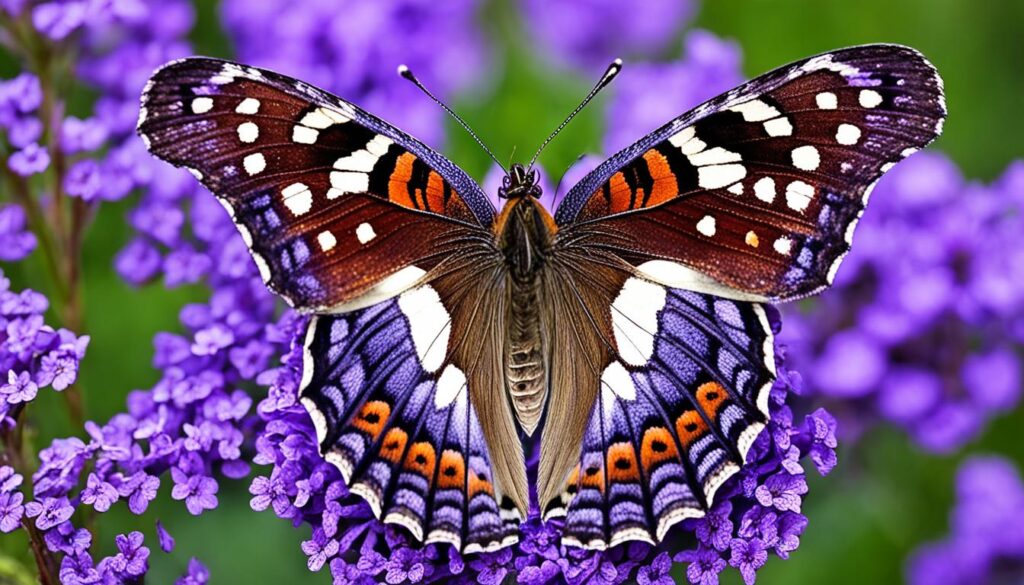
These beautiful creatures are truly a sight to behold. With their dark wings and iridescent charm, the purple emperor butterfly showcases the natural allure and wonder of the animal kingdom.
Notable Features of the Purple Emperor Butterfly:
- Majestic presence in wooded areas
- Dark wings with a purplish-blue iridescent sheen
- Vibrant coloration in males, more subdued in females
- Unique feeding habits
Blue Pleasing Fungus Beetle
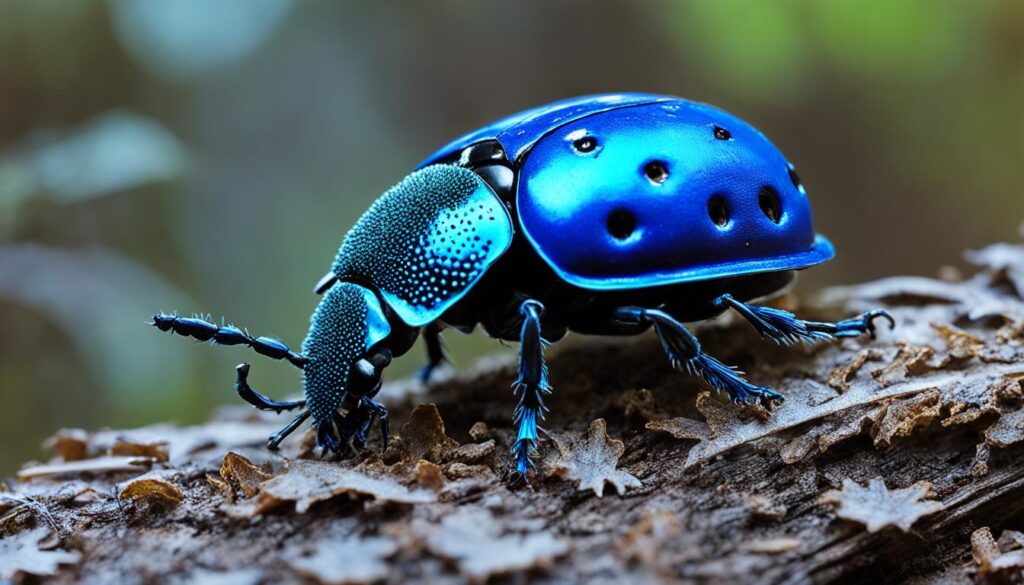
The blue pleasing fungus beetle is a species known for its beautiful lavender color and distinctive markings. These beetles are often described as being “blue,” although their coloration is closer to lavender. They have black heads and legs, with small black spots covering their wings. Interestingly, these beetles change color as they age, with younger individuals displaying brighter shades of purple or blue.
Unique Markings
The blue pleasing fungus beetle stands out with its unique markings, which add to its allure. The black spots covering its wings create an eye-catching pattern against the lavender background, making it easily recognizable in its natural habitat.
“The blue pleasing fungus beetle showcases a captivating combination of lavender color and intricate markings.”
These distinct features not only make the beetle visually appealing but also serve as a defense mechanism against predators. The unique markings make it harder for predators to spot the beetle amidst its surroundings, increasing its chances of survival.
Color Changes
One of the fascinating characteristics of the blue pleasing fungus beetle is its color-changing ability. As the beetles age, their coloration shifts, resulting in a change in their overall appearance. Young beetles typically display brighter shades of purple or blue, while older individuals exhibit a more subdued lavender hue.
This color variation throughout their lifespan adds an element of intrigue to these already captivating creatures, showcasing their ability to adapt and transform over time.
Comparison of Blue Pleasing Fungus Beetle’s Coloration
| Age | Coloration |
|---|---|
| Youthful | Bright shades of purple or blue |
| Mature | Subdued lavender hue |
The color-changing nature of the blue pleasing fungus beetle adds to its mystique, making it a truly unique and captivating species in the animal kingdom.
Purple Grenadier
We now turn our attention to the fascinating purple grenadier, an African bird known for its unique plumage. These colorful birds inhabit shrubby areas in several African countries, showcasing a captivating combination of reddish and soft bluish-purple feathers.
The males of the purple grenadier species have chestnut red bodies with striking purple bellies and faces. Their vibrant colors make them stand out against the lush greenery of their surroundings. On the other hand, females display a paler buff color with purplish markings, creating an elegant and understated appearance.
The purple grenadier’s distinctive reddish and purple plumage serves both functional and visual purposes. These birds blend remarkably well with the foliage, offering camouflage against potential predators. In addition, their bright and eye-catching colors also contribute to their courtship display, capturing the attention of potential mates.
Observing the purple grenadier in its natural habitat is a delightful experience for bird enthusiasts and nature lovers alike. The contrast between the deep reds and soft purples against the African landscape creates a visual spectacle that is truly a sight to behold.
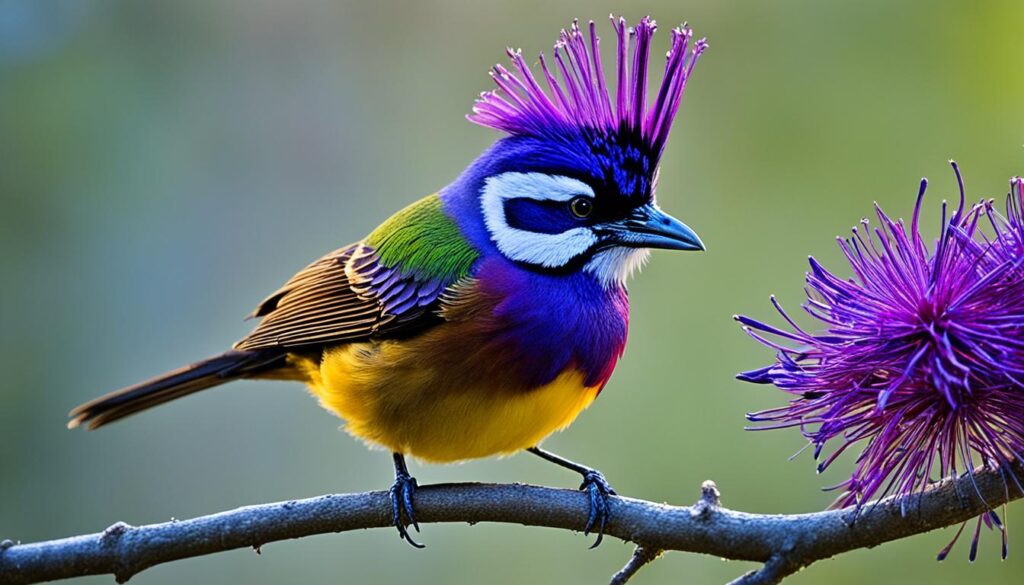
These colorful birds inhabit shrubby areas in several African countries and are known for their bright and eye-catching appearance.
Indian Purple Frog
The Indian purple frog, scientifically known as Nasikabatrachus sahyadrensis, is a unique and captivating amphibian species found exclusively in the Western Ghats region of India. Despite its name, the color of the Indian purple frog varies from purplish-gray to brownish, depending on the individual.
What sets this frog apart is its distinct appearance and features. It has a stocky body with a short and chubby shape, contributing to its adorable yet unusual appeal. The most distinguishing characteristic of the Indian purple frog is its long, pig-like nose, which gives it a distinctively different look from other frog species. This peculiar snout plays a vital role in the frog’s survival, helping it burrow underground with ease.
Another intriguing aspect of the Indian purple frog is its vocalization. Rather than croaking like most frogs, it produces a unique clucking sound that resembles the vocalization of chickens. These distinctive calls can be heard during the breeding season, serving as a means of communication between individuals.
Unfortunately, the Indian purple frog is facing significant threats and is currently classified as an endangered species. The destruction and fragmentation of its habitat due to deforestation and urbanization pose severe challenges to its survival. Additionally, the amphibian’s specialized burrowing habits make it highly vulnerable to changes in its environment.
To raise awareness about the Indian purple frog’s conservation needs, efforts are underway to protect and preserve its habitat, educate local communities, and conduct further research on its ecology and biology.
Quick Facts: Indian Purple Frog
| Scientific Name | Nasikabatrachus sahyadrensis |
|---|---|
| Common Name | Indian Purple Frog |
| Color | Purplish-gray to brownish |
| Habitat | Western Ghats region of India |
| Main Features | Stocky body, short and chubby shape, long pig-like nose |
| Unique Vocalization | Clucking chicken-like calls |
| Status | Endangered |
Despite its endangered status, the Indian purple frog continues to captivate researchers and nature enthusiasts alike with its intriguing appearance and behaviors. Efforts to conserve this unique species are vital to ensure its survival and maintain the rich biodiversity of the Western Ghats region.
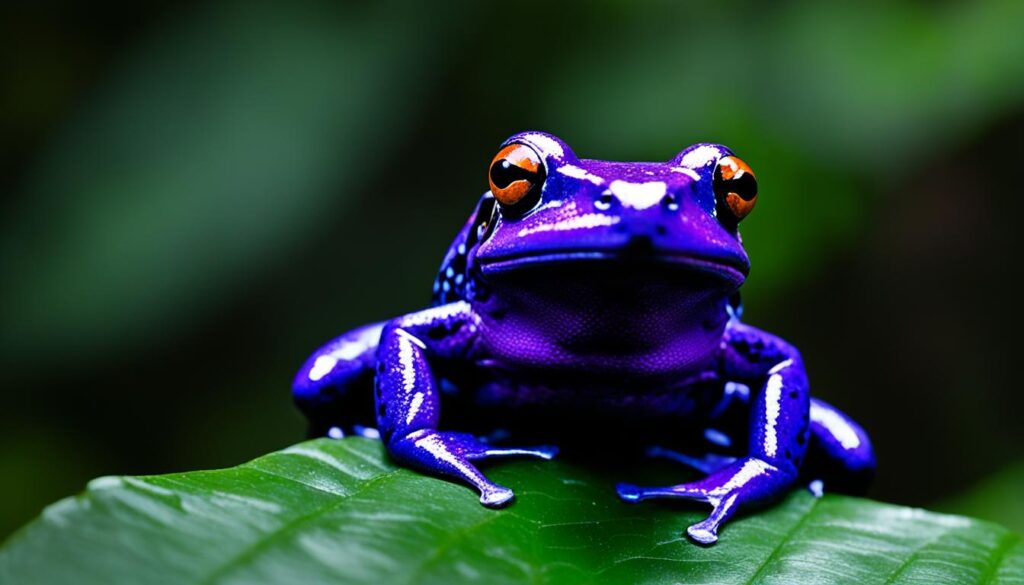
Conclusion
Purple animals captivate us with their rare beauty and serve as a testament to the remarkable diversity of nature. From the violet-backed starling of sub-Saharan Africa to the purple honeycreeper of South America, these creatures showcase vibrant shades of purple that are truly awe-inspiring.
Their stunning colors have evolved for specific purposes, whether it’s attracting mates or warning predators of their toxic nature. The purple sea slug, with its electric hue, adds a splash of color to the Indo-Pacific’s coral reefs, while the purple emperor butterfly showcases its iridescent wings in wooded areas across Europe and China.
While purple animals may be few and far between, they leave a lasting impression on anyone lucky enough to encounter them. Their presence in nature reminds us of the rare and extraordinary beauty that exists all around us, and the importance of preserving these natural wonders for generations to come.
